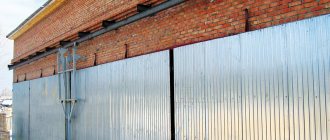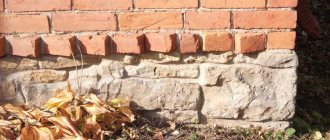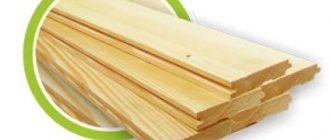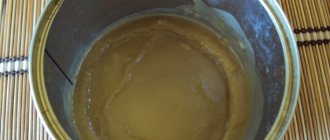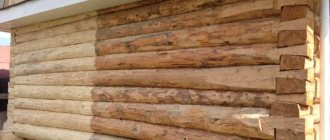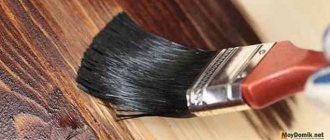22.08.2016
In the absence of proper treatment, the wood begins to crack, although well-dried and treated timber can also crack, albeit slightly. Cracks in the timber “destroy” the entire wooden structure. Small and shallow cracks spoil the appearance of the house, dirt accumulates in the cracks, the wood begins to get wet, large and deep cracks lead to heat loss in the building, significantly increasing heating costs.
Not everyone knows what to do in such cases: what causes cracks to form in timber and how to properly treat cracks.
Causes
The main reason for the formation of cracks in timber is high moisture content of the wood. Cracks in such timber can reach several centimeters in width and many times more in depth, up to the formation of a through crack. The next equally important reason is shrinkage of the house. With proper control of the shrinkage of the house, you can avoid the formation of a large number of cracks and get by with only small cracks, which will exclusively affect the appearance of the timber and the house itself, but this is a matter of taste. Other reasons may be: improper installation of the structure, too high or too low humidity in the house, ground movement, etc.
Putty
This technique is used in cases where there is a small crack or chip on the tree. It is important to note that sealing cracks using putty gives a cosmetic rather than a practical effect. Moreover, even such sealing of cracks will allow you to perform any operations on the tree again, without fear of damaging it even more (for example, you can safely saw it).
Also, it is strongly recommended to putty before painting the material. To eliminate defects, you must first prepare a mixture purchased at the store. The resulting substance is applied to the damaged surface using a staple so as to fill all the cavities. You will definitely need to wait for the mixture to dry (this will take 15-20 minutes), after which you can begin secondary processing.
We suggest you read: Paper beacons are a myth, they don’t exist
How to get rid of cracks?
What to do if cracks do appear? How to process them correctly?
First, you need to take into account that even after the house has stood for 2-3 years after construction, when it has gone through several heating seasons and there are no signs of trouble, the timber can still continue to crack, and existing cracks can increase. The harsh Russian climate has not been canceled, so it is worth taking into account significant fluctuations in temperature and humidity.
Small cracks in the timber can be left unattended, that is, without treatment, since they do not in any way affect the heat loss of the structure. The only question remains is their visual perception. If desired, they can be sealed with special putty or.
Larger cracks should not be ignored. Sealing cracks with sealant will help avoid serious heat loss and save on heating costs at home.
How to treat timber
Now that we know where the legs of our problem come from, and how all this can be solved, let’s see what can really be used to treat the ends of the beam so that it does not crack.
Lime is a cheap natural antiseptic, but few people know that it protects wood well from solar ultraviolet radiation and prevents it from drying unevenly.
However, do not rush to take up the popcorn. Firstly, lime is washed off very quickly, and secondly, it does not have the most pleasant color.
Would you like the ends of your beautiful log house to turn white with stains? Agree, this protection is for the most extreme cases.
You can also protect the ends with any breathable paint. Today there are more than enough of them on sale. But, again, the wood texture will be lost, but the capillarity in the beams will be completely killed. It’s a fact that if you cover previously chamber-dried wood with good paint, the likelihood of it cracking will be minimized.
Another thing is that the paints and varnishes supplied to the market are in no way inferior in cost to specially developed impregnations, and more often than not they cost significantly more, so what’s the point in reinventing the wheel then?
Another remedy we inherited from our ancestors is beeswax. The ends sealed with it remain transparent for steam exchange, but not for moisture. Plus, this material is of natural origin, 100% safe for human life and time-tested.
Another thing is that working with such a product is extremely inconvenient; it requires constant heating, and also makes the wood more susceptible to fire.
True, today manufacturers have refined the idea of their ancestors and created wax-based mastics that are easy to use, which, in addition to the properties described above, improve the mechanical properties of wood and give it a beautiful silky shine. The only problem is the price. Not everyone's budget allows them to purchase such a miracle.
Polymer impregnations
Along with natural ones, there are also polymer impregnations on sale. The same “Senezh Tor”, “Neomid Thor Plus” or “Biotor” from the Rogneda brand. These compounds are pure chemistry.
But they do their job perfectly, are relatively cheap, easy to use and colorless. If you need a wooden texture in its pure form, you can’t do without polymer.
Only supporters of “green” housing will remain dissatisfied here. And this is logical. What's the point of building a house from natural materials and then saturating it with chemicals?
In a word, how to care for your log house and what impregnations or mastics to choose for this is a personal matter for the owner. It is enough to know that today there is a choice and cracking, which was perceived by many as a death sentence, is quite possible to avoid, or at least minimize it.
With this we say goodbye to you. Goodbye and see you soon on the pages of the site about the dacha.
How to apply?
— Clean the cracks from dust, dirt and loose particles — At positive temperatures and low humidity, dampen the surface of the cracks (the presence of dripping moisture does not add to the problem) — If the width of the crack in the timber exceeds 3 mm, it should be sealed in order to control the thickness of the sealant application and avoid it significant overspending - If necessary, cover the edges of the crack with masking tape (to protect the surface of the wood and form an even seam of sealant) - Insert the tube with sealant into and cut off the plastic cone nozzle at an angle of 45o - Apply sealant evenly into the crack using a mounting gun - Level the surfaces of the sealant with using a putty knife - Remove the masking tape
are presented in a large assortment of colors, so choosing the color you need will not be difficult, the main thing is not to forget that it is best to choose a color as close as possible to the color of the wood finish.
Ways to protect wood
Now you know why profiled timber cracks . There are several ways to combat this. Here are the most common:
- Dry for a long time. It will take at least two years for the logs to dry completely. Only then will they not crack so much, and the size of the cracks will be within 1-2 mm.
- Make a compensation cut. The effectiveness of this method is questionable; there are still debates about its feasibility and safety.
- Drying with high-frequency currents - in this case, the process occurs as if from the inside - first the insides dry, and then the surface. However, the cost of wood dried in this way is simply exorbitant. In addition, some experts are not confident in the harmlessness of exposure to high-frequency currents.
- Chamber drying is the most preferred method. This is how most manufacturers dry the material.
Prevention
What to do to prevent cracks from occurring?
First of all, you need to choose the right material for construction. Many companies are engaged in the construction of houses made of timber and before purchasing from them you can choose the quality of the wood. But remember that even treated and properly dried wood does not give you a 100% guarantee against the formation of cracks.
A mixture of glue and wood shavings
Also, in addition to the material for sealing cracks, you can also use a mixture made from wood glue and small wood shavings. This method is not suitable for correcting wide depressions and leveling large surfaces, but it is more reliable as an alternative to putties during local repair of cracks.
In those places where the putty composition will sooner or later begin to crack due to various factors such as seasonal fluctuations, a self-made glue filler will be able to withstand the test of time. It is recommended for use for sealing cracks along carpentry joints, repairing cracks in wood doors and other places where the seam is subject to stress.
Epoxy resin
After hardening, the epoxy resin will begin to gain strength, which exceeds the strength of wood, and due to its fluidity and excellent adhesion, it will penetrate into all cavities and thus restore the original integral structure of the wooden product, and will also prevent the further spread of cracks. This method is often used when working with solid wood, when the problem of cracks worsens due to high internal stress.
After the epoxy resin has completely hardened, it will turn into an inert and completely safe plastic that will have increased strength. The resin can be used to repair defects in products that come into contact with food, such as repairing kitchen countertops or repairing cracks in a cutting board or dining table.
Epoxy resin makes it possible not only to fill a crack in a beam/log/wood product and thereby hide cosmetic defects, but also to completely stabilize the condition of the wood. Often this is only the only opportunity to bring back to life a timber that seems to be completely and completely damaged by through cracks, as shown in the photo below.
Butterfly dowels for crack stabilization
We suggest you read: How to seal cracks in a brick oven
Large cracks can become not just a headache, but even a natural decoration of the overall design of the project. To a greater extent, this will apply to products made from slabs - these are massive cuts of wood, which are subsequently used to make table covers, seats for benches and other elements. In such furniture, wide cracks can preserve the philosophy of the Live ege style, which is characterized by interference with the natural forms of wood.
Wax correctors
Special sticks made from hard wax are a simple and extremely convenient solution for cosmetic repairs of small cracks, dents, chips, deep scratches and other defects. Wax correctors have become very popular as a means of redecorating furniture and other wooden products that are used indoors and are not subject to much wear and tear.
Before starting work, the area to be repaired should be prepared - clean it of dust and various contaminants, remove chipped nicks. Wax correctors should be used at a temperature that is not lower than 10 degrees. First, polish the restoration site gently with a lint-free cloth. Next, you should apply the wax with force to the damaged areas so that it is thoroughly packed into all cavities.


